Experimental Study of a New Self-Centering BRB and Its Application in Seismic Resistance of Frame Structure
Abstract
1. Introduction
2. Configuration of New ST-SC-BRB
3. ST-SC-BRB Experimental Program
3.1. Brace Design and Testing Protocol
3.2. Test Results and Discussion
3.2.1. Test Observations
3.2.2. Hysteresis Behavior
3.2.3. Performance Evaluation
4. Seismic Analysis of Self-Centering Braced Steel Frame Structures
4.1. Structural Model and Design Parameters
4.2. Simplified Finite Element Model of the Structure
4.3. Seismic Wave Selection
4.4. Analysis of Structural Seismic Performance
5. Brace Design Parameters on the Seismic Performance of Structures
5.1. Design Parameters of the Brace
5.2. Results and Discussion
5.2.1. Effect of First Stiffness
5.2.2. Effect of Second Stiffness
5.2.3. Effect of Self-Centering Ratio
6. Conclusions
- As the restrained steel tube in the traditional all-steel BRB is used as the inner tube of the PT system, the new ST-SC-BRB component can greatly simplify the construction of the traditional dual-tube or multi-tube SC-BRB.
- The cyclic test results show that the proposed ST-SC-BRB exhibits excellent self-centering ability without significantly increasing its energy-dissipation capacity compared to the conventional BRB. At a displacement load of 6 mm, the ST-SC-BRB exhibits an average residual deformation of 0.81 mm.
- Compared with the steel frame structures with traditional BRBs, the maximum story drift of structures with ST-SC-BRBs under seismic loads is reduced, and the corresponding residual deformation is remarkably reduced by up to 74%.
- The initial stiffness of the ST-SC-BRB component significantly influences the seismic response of the structure, while the self-centering ratio of the ST-SC-BRB component is a crucial factor in determining the residual deformation of the structures. To achieve a better self-centering ability, the self-centering ratio of the ST-SC-BRB should be greater than 1.0.
Author Contributions
Funding
Data Availability Statement
Conflicts of Interest
References
- Xu, G.; Guo, T.; Li, A.; Wang, S.; Zhang, R.; Zhu, R.; Xu, J. Review on self-centering damper for seismic resilient building structures. Structures 2023, 54, 58–77. [Google Scholar] [CrossRef]
- Liu, C.; Xu, D. Diagrid Core-tube Structure Seismic Performance Based on Equivalent Stiffness Ratio of Inner and Outer Tubes. KSCE J. Civ. Eng. 2023, 27, 1682–1696. [Google Scholar] [CrossRef]
- Wei, J.G.; Ying, H.D.; Yang, Y.; Zhang, W.; Bao, C.G. Seismic performance of concrete-filled steel tubular composite columns with ultra high performance concrete plates. Eng. Struct. 2023, 278, 115500. [Google Scholar] [CrossRef]
- Deng, E.F.; Wang, Y.H.; Zong, L.; Zhang, Z.; Zhang, J.F. Seismic behavior of a novel liftable connection for modular steel buildings: Experimental and numerical studies. Thin-Walled Struct. 2024, 197, 111563. [Google Scholar] [CrossRef]
- Nuzzo, I.; Losanno, D.; Caterino, N. Seismic design and retrofit of frame structures with hysteretic dampers: A simplified displacement-based procedure. Bull. Earthq. Eng. 2019, 17, 2787–2819. [Google Scholar] [CrossRef]
- Zhou, Y.; Tian, W.; Xiao, Y. Design recommendations for self-centering buckling restrained braces. Eng. Struct. 2022, 273, 115019. [Google Scholar] [CrossRef]
- Huang, W.; Shen, M.; Liu, J.; Wang, L.; Liu, X.; Zhou, Z. Study on seismic performance of an innovative single-tube self-centering buckling-restrained brace. J. Constr. Steel Res. 2023, 211, 108185. [Google Scholar] [CrossRef]
- Liu, J.; Qiu, C.; Zhang, Y.; Liu, H.; Du, X. Hysteretic model and seismic performance of a self-centering brace equipped with energy absorbing steel plate clusters. Structures 2023, 57, 105153. [Google Scholar] [CrossRef]
- Christopoulos, C.; Tremblay, R.; Kim, H.J.; Lacerte, M. Self-Centering Energy Dissipative Bracing System for the Seismic Resistance of Structures: Development and Validation. J. Struct. Eng. 2008, 134, 96–107. [Google Scholar] [CrossRef]
- Hashemi, S.V.; Miri, M.; Rashki, M.; Etedali, S. Multi-objective optimal design of SC-BRB for structures subjected to different near-fault earthquake pulses. Structures 2022, 36, 1021–1031. [Google Scholar] [CrossRef]
- Miller, D.J.; Fahnestock, L.A.; Eatherton, M.R. Development and experimental validation of a nickel–titanium shape memory alloy self-centering buckling-restrained brace. Eng. Struct. 2012, 40, 288–298. [Google Scholar] [CrossRef]
- Zhou, Z.; Xie, Q.; Lei, X.C.; He, X.T. Experimental Investigation of the Hysteretic Performance of Dual-Tube Self-Centering Buckling-Restrained Braces with Composite Tendons. J. Compos. Constr. 2015, 19, 4015011. [Google Scholar] [CrossRef]
- Zhou, Y.; Shao, H.; Cao, Y.; Lui, E.M. Application of buckling-restrained braces to earthquake-resistant design of buildings: A review. Eng. Struct. 2021, 246, 112991. [Google Scholar] [CrossRef]
- Xu, L.; Chen, P.; Li, Z. Development and validation of a versatile hysteretic model for pre-compressed self-centering buckling-restrained brace. J. Constr. Steel Res. 2021, 177, 106473. [Google Scholar] [CrossRef]
- Nazarimofrad, E.; Shokrgozar, A. Seismic performance of steel braced frames with self-centering buckling-restrained brace utilizing superelastic shape memory alloys. Struct. Des. Tall Spec. Build. 2019, 28, e1666. [Google Scholar] [CrossRef]
- Ghowsi, A.F.; Sahoo, D.R. Seismic response of SMA-based self-centering buckling-restrained braced frames under near-fault ground motions. Soil Dyn. Earthq. Eng. 2020, 139, 106397. [Google Scholar] [CrossRef]
- Zhang, C.; Zong, S.; Sui, Z.; Guo, X. Seismic performance of steel braced frames with innovative assembled self-centering buckling restrained braces with variable post-yield stiffness. J. Build. Eng. 2023, 64, 105667. [Google Scholar] [CrossRef]
- Koetaka, Y.; Narihara, H.; Tsujita, O. Experimental study on buckling restrained braces. In Proceedings of the Sixth Pacific Structural Steel Conference, Beijing, China; 2001; Volume 1, pp. 208–213. [Google Scholar]
- T/CECS 817-2021; Technical Specification for Application of Buckling Restrained Brace. China Architecture and Building Press: Beijing, China, 2021. (In Chinese)
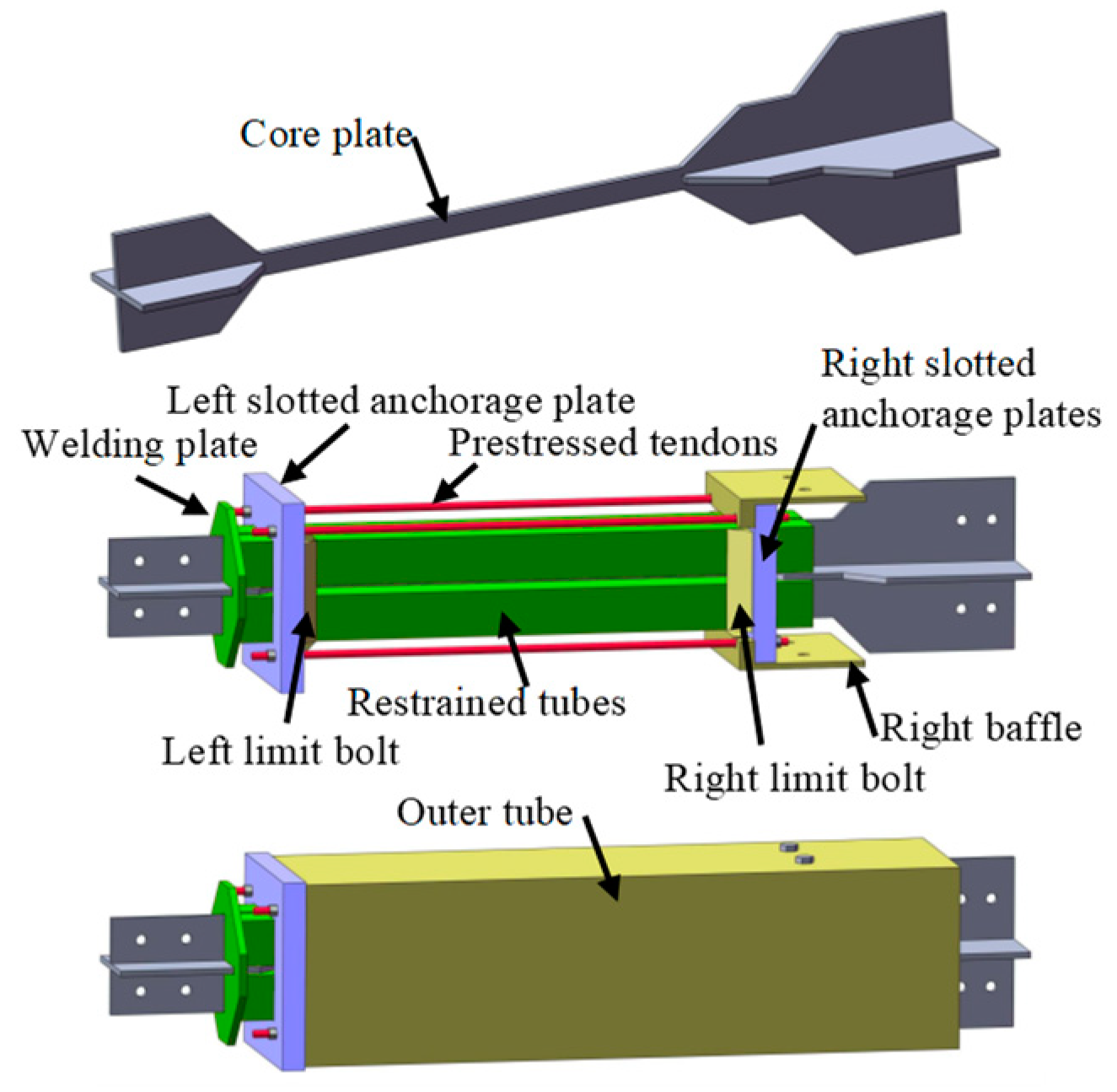





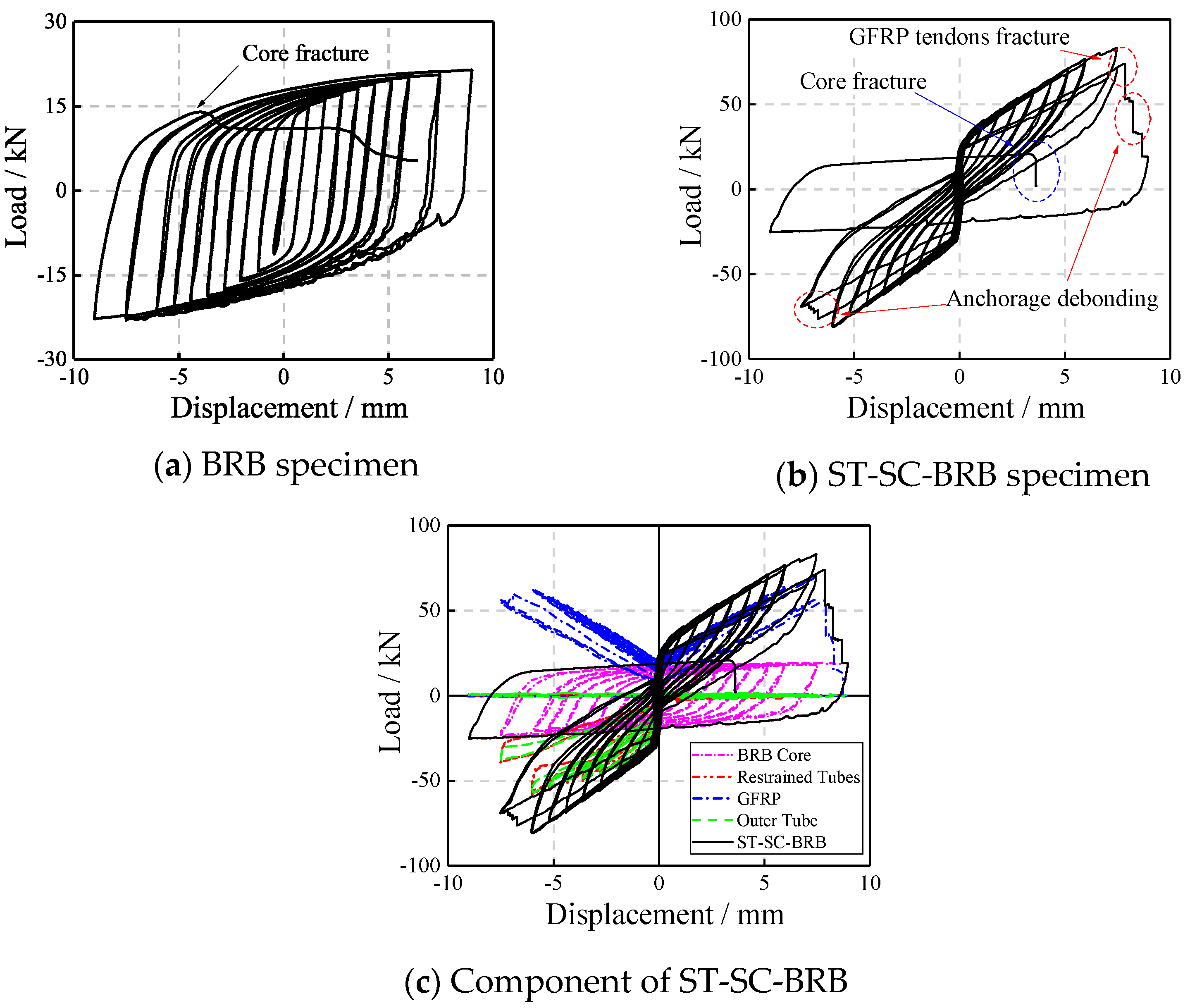
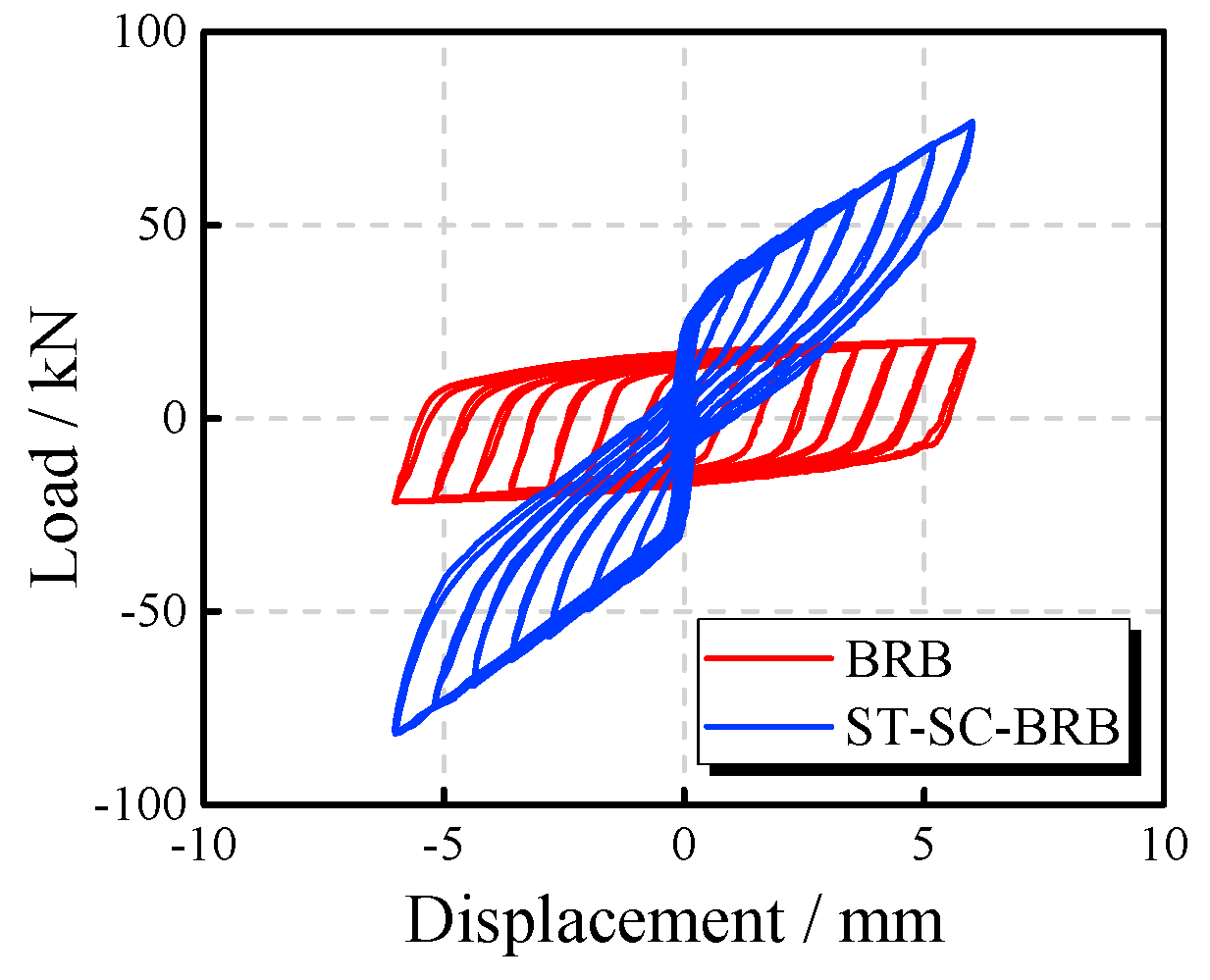
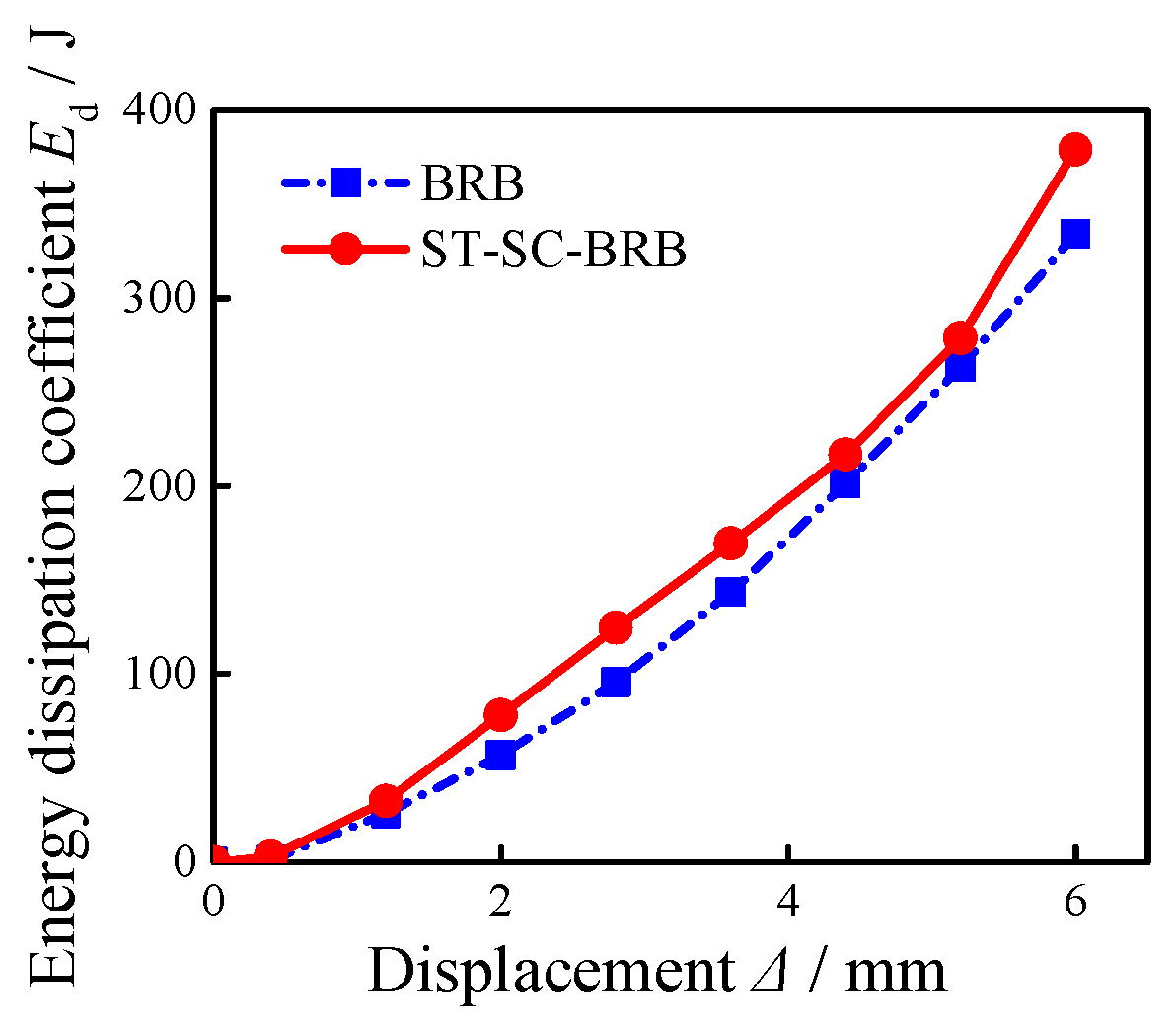


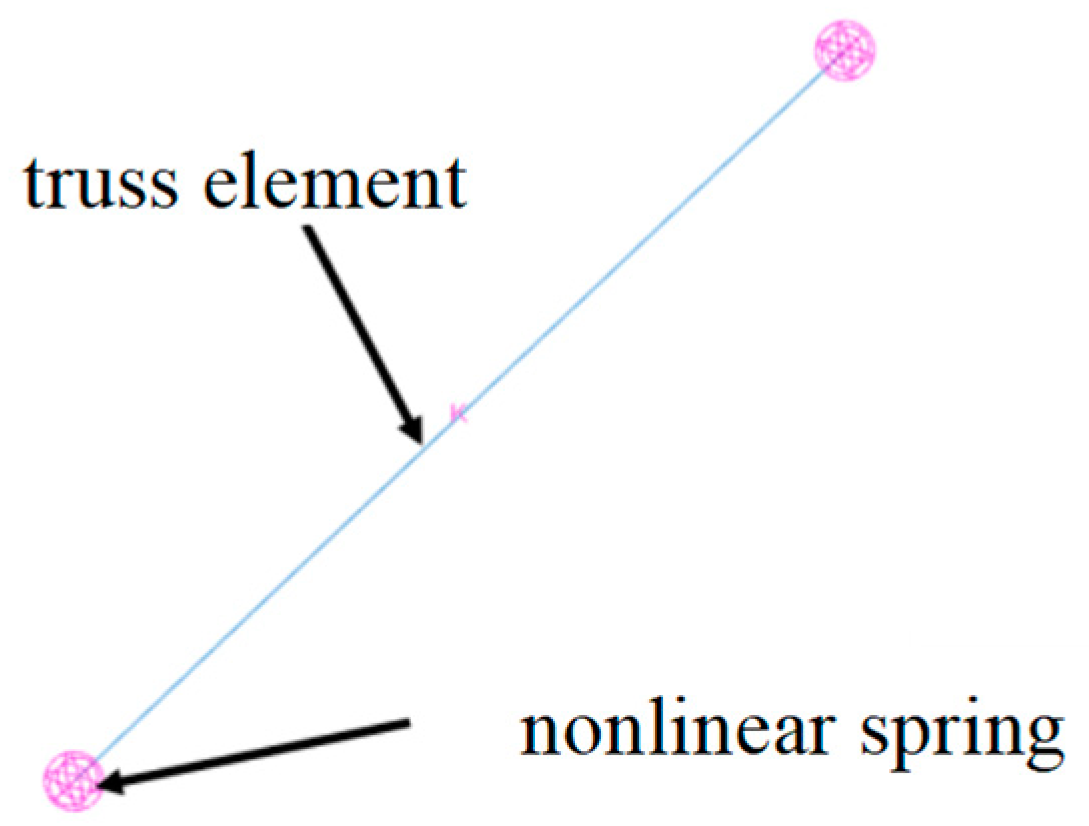










| Core | Outer Tube | Restrained Tubes × 4 | Limit Bolt | Tendons × 4 | Left End Plate | Right End Plate |
|---|---|---|---|---|---|---|
| 12 × 4 | 130 × 130 × 5 | 30 × 30 × 3 | 14 × 14 × 66 | 6 × 300 | 124 × 124 × 15 −66 × 66 × 15 | 104 × 104 × 15 −66 × 66 × 15 |
| Member | Cross-Section Size H × B × tw × tf/mm |
|---|---|
| 1–3 story columns | 450 × 450 × 16 × 24 |
| 4–6 story columns | 350 × 350 × 12 × 21 |
| Beams | 450 × 300 × 12 × 18 |
| No. | Earthquake Site | Time | Recording Station | Selected Component |
|---|---|---|---|---|
| 1 | Imperial Valley | 19 May 1940 | 117 El Centro Array#9 | I-ELC180 |
| 2 | Chi-Chi, Taiwan | 20 September 1999 | CHY028 | CHY028-N |
| 3 | Imperial Valley | 15 October 1979 | 5054 Bonds Corner | H-BCR230 |
| 4 | Duzce, Turkey | 12 November 1999 | Bolu | BOL000 |
| 5 | San Fernando | 9 February 1971 | 135 LA-Hollywood Store Lot | PEL090 |
| 6 | Erzincan, Turkey | 13 March 1992 | 95 Erzincan | ERZ-EW |
| NO. | Parameters |
|---|---|
| SCBRBF-0 | Benchmark |
| SCBRBF-1 | First stiffness × 0.5 |
| SCBRBF-2 | First stiffness × 1.5 |
| SCBRBF-3 | Second stiffness × 0.5 |
| SCBRBF-4 | Second stiffness × 1.5 |
| SCBRBF-5 | Self-centering ratio × 0.5 |
| SCBRBF-6 | Self-centering ratio × 1.5 |
Disclaimer/Publisher’s Note: The statements, opinions and data contained in all publications are solely those of the individual author(s) and contributor(s) and not of MDPI and/or the editor(s). MDPI and/or the editor(s) disclaim responsibility for any injury to people or property resulting from any ideas, methods, instructions or products referred to in the content. |
© 2024 by the authors. Licensee MDPI, Basel, Switzerland. This article is an open access article distributed under the terms and conditions of the Creative Commons Attribution (CC BY) license (https://creativecommons.org/licenses/by/4.0/).
Share and Cite
Lin, Y.; Zhou, Z.; Shen, M.; Liu, J.; Huang, W. Experimental Study of a New Self-Centering BRB and Its Application in Seismic Resistance of Frame Structure. Buildings 2024, 14, 850. https://doi.org/10.3390/buildings14030850
Lin Y, Zhou Z, Shen M, Liu J, Huang W. Experimental Study of a New Self-Centering BRB and Its Application in Seismic Resistance of Frame Structure. Buildings. 2024; 14(3):850. https://doi.org/10.3390/buildings14030850
Chicago/Turabian StyleLin, Yourong, Zhi Zhou, Maoyu Shen, Jili Liu, and Wei Huang. 2024. "Experimental Study of a New Self-Centering BRB and Its Application in Seismic Resistance of Frame Structure" Buildings 14, no. 3: 850. https://doi.org/10.3390/buildings14030850
APA StyleLin, Y., Zhou, Z., Shen, M., Liu, J., & Huang, W. (2024). Experimental Study of a New Self-Centering BRB and Its Application in Seismic Resistance of Frame Structure. Buildings, 14(3), 850. https://doi.org/10.3390/buildings14030850






